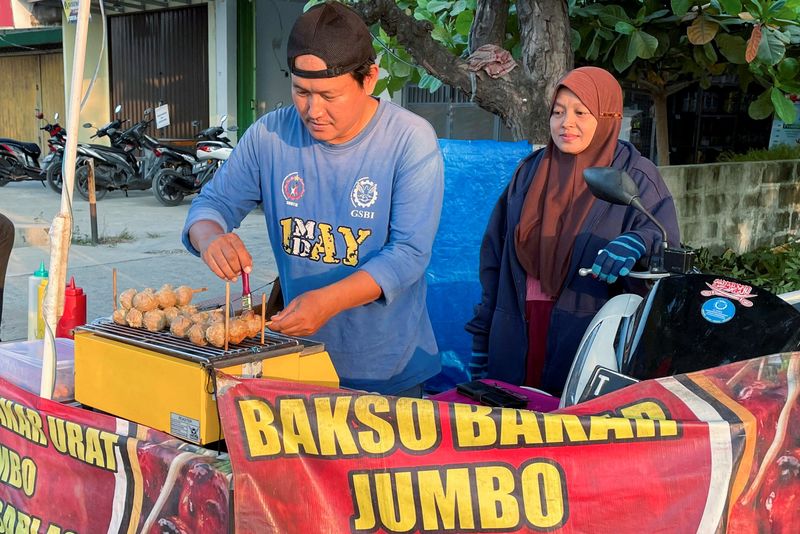By Stefanno Sulaiman
KARAWANG, Indonesia (Reuters) – Rahmat Hidayat lost his job when the shoe factory where he worked closed last year in the industrial city of Karawang in West Java, Indonesia.
The 44-year-old now earns less than half of what he used to earn selling grilled meatballs. Unable to afford his wife’s diabetes medication, Rahmat instead picks herbs to make a tonic.
Like Rahmat, millions of middle-class Indonesians have become poorer, largely due to an increase in layoffs and a decline in job creation since the pandemic.
The trend bodes ill for the outlook for Southeast Asia’s largest economy. Household consumption accounts for more than half of gross domestic product. There is also a common assumption that a growing middle class will fuel Indonesia’s ambition to become a high-income country by 2045.
It also poses a challenge to the incoming government of President Prabowo Subianto, who won a landslide in February elections on promises to boost economic growth and create 19 million jobs. Prabowo takes office on October 20.
“It is difficult to grow the economy when consumption is low,” said Mohammad Faisal, an economist at the Jakarta-based Center of Reform on Economics.
The government classifies those who spend between $132 and $643 a month as middle class, based on a World Bank criterion. This group is essential for economic growth, as their spending accounts for almost 40% of private consumption, and more than 80% when combined with the aspirational middle class, which spends $57 to $132.
However, according to official data released last month, the size of the middle class has fallen from 21.5% of the total population in 2019 to 17.1% in 2024.
While the Indonesian economy has recovered from the pandemic, growing at over 5% annually since 2022 and with generally low inflation, this shrinking middle class is likely to weigh on future growth as the government faces lower tax revenues and potentially more subsidies, said Jahen Rezki, an analyst at the University of Indonesia.
“In the long run, the shrinking middle class will certainly be a big burden for the state,” he said.
LARGE GOVERNMENT EXPENDITURES
One of the main reasons for the decline of the middle class is the changing labor market.
Much of the foreign investment in Indonesia is focused on sectors such as mining. These sectors are becoming less labor-intensive as more advanced technology is used.
In addition, increased competition from cheaper destinations such as China, particularly in the textile sector, has led to tight factory sizes, with the textile union saying these are the worst layoffs in a decade.
Prabowo’s brother and adviser Hashim Djojohadikusumo said the new government will help the middle class by creating millions of new jobs through projects such as the $28 billion free meals program and the construction of millions of homes.
“We want to create a lot of small, medium and micro entrepreneurs, for example through our housing program. We want to build 3 million houses, in villages and towns. That is to create a middle class,” he told Reuters recently.
But how much the next government can spend on social services will likely be limited, especially next year when much of the government’s debt matures, said Teguh Yudo Wicaksono, an economist at Islam Internasional Indonesia University.
For former factory worker Rahmat, the best help the government can offer is a financial contribution to help him expand his food business, as it has become increasingly difficult to find work.
His wife Fatimah says her children often ask for their favourite spicy meat dish, but she can usually only afford to feed them instant noodles with eggs.
“All I could tell my children was to wait until daddy gets a fair compensation from the factory. Then we will cook a delicious meal again,” she said.
($1 = 15,405.0000 rupiah)
(Reporting by Stefanno Sulaiman; additional reporting by Gayatri Suroyo; editing by Miral Fahmy)

